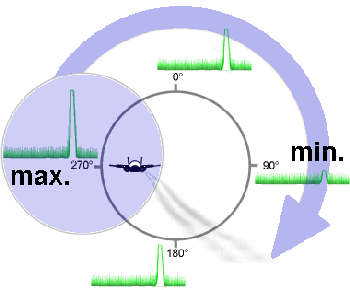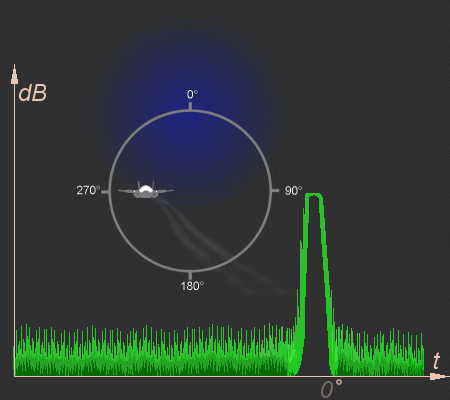| Some older tracking radar uses the conical scanning
principle.
You can generate a conical scan pattern, as shown in figure 1, by using a rotating feed driven by a motor in the housing at the rear of the dish. The axis of the radar lobe is made to sweep out a cone in space; the apex of this cone is, of course, at the radar transmitter antenna or reflector. |
 
Figure 1: At conical scan the antenna traces a cone pattern around its central axis. Used in tracking radars with target azimuth and elevation being taken from the mechanical position of the antenna. |
At any given distance from the antenna, the path of the lobe axis is a circle. Within the useful range of the beam, the inner edge of the lobe always overlaps the axis of scan.
Now assume that we use a conically scanned beam for target tracking. If the target is on the scan axis, the strength of the reflected signals remains constant (or changes gradually as the range changes). But if the target is slightly off the axis, the amplitude of the reflected signals will change at the scan rate. For example, if the target is to the left of the scan axis, as shown in the following animation the reflected signals will be of maximum strength as the lobe sweeps through the left part of its cone; the signals will quickly decrease to a minimum as the lobe sweeps through the right part. Information on the instantaneous position of the beam, relative to the scan axis, and on the strength of the reflected signals is fed to a computer. Such a computer in the radar system is referred to as the angle-tracking or angle-servo circuit (also angle-error detector). If the target moves off the scan axis, the computer instantly determines the direction and amount of antenna movement required to continue tracking. The computer output is used to control servomechanisms that move the antenna. In this way, the target is tracked accurately and automatically.


An animation of the Conical Scan
Commonly used conical scan pattern include Conical Scan on Receive Only (abbreviated to COSRO) in which a conical scan pattern is used while the radar is in receive mode only.